BANG! 50-metres below something hit my jighead with the force of a breakers lump hammer. The rod tip powered down in to the full fighting curve as a massive weight bored hard for the seabed dragging yard after yard of line off a tightly set clutch. The only option was to hang on and let the fish sap some of its strength, then pump the fish hard to gain a few feet before that hard won line was dragged off the reel again and again. Some 40-feet down in the crystal clear water a flash of white could be seen. At 20-feet the fish looked huge, and as it broke surface it became a giant. It was a personal best cod weighing 38lbs. A Loppa Whopper!
A four man team consisting of Ian Peacock, UK representative for the Norwegian tour company Din Tur, Barney Wright, editor of TSF, Roger Mortimore, sub editor, and myself headed to Loppa in the far north of Norway with two prime targets. One was to catch the holy grail of European sea angling, a halibut, the other to assess the cod fishing and general potential of an area only just being opened up to UK anglers.
Base camp was the village of Tverfjord situated inside Langfjord south of Silda Island. This gave us access to ground inside Langfjord, other known fishing grounds around Maroy Island, both Northbergsfjord and Southbergsfjord, but importantly the ground west, northwest and north of Loppa Island.
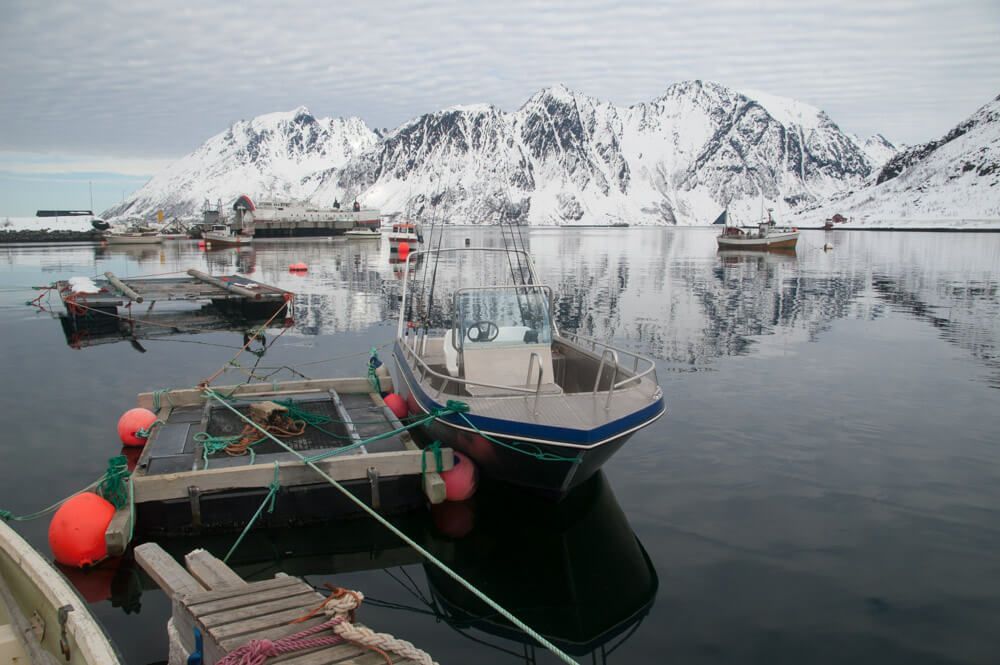
With this area being new and unexplored by UK anglers we chose to split in to two man teams and spend the first three days surveying the ground relatively close to base camp. This is ground that could be fished in most weather conditions meaning few if any days would be lost for future visiting anglers.
Ian and Roger fished ground inside Silsporden Sound between Silda and Maroy Island taking cod to double figures, wolffish, torsk and haddock, but also found good cod when drifting down the west side of Maroy, and also off a rocky point where shallow water drops away deep at Panarskj at the entrance to Langfjord less than a mile away from the boat dock.
The two lads then ventured northwards to the top of Northbergsfjord, a run of about 25 minutes, where the chart indicates superb featured ground named Rundskj and Konesgr with depths from 30-metres dropping in to 100-metres plus. The local Norwegian longliners were already working this ground, but the guys made drifts between and outside the lines and enjoyed incredible fishing with huge numbers of cod in to the high teens in weight. Their tackle was typically a pirk at the bottom with a single, or two flyer lures above.
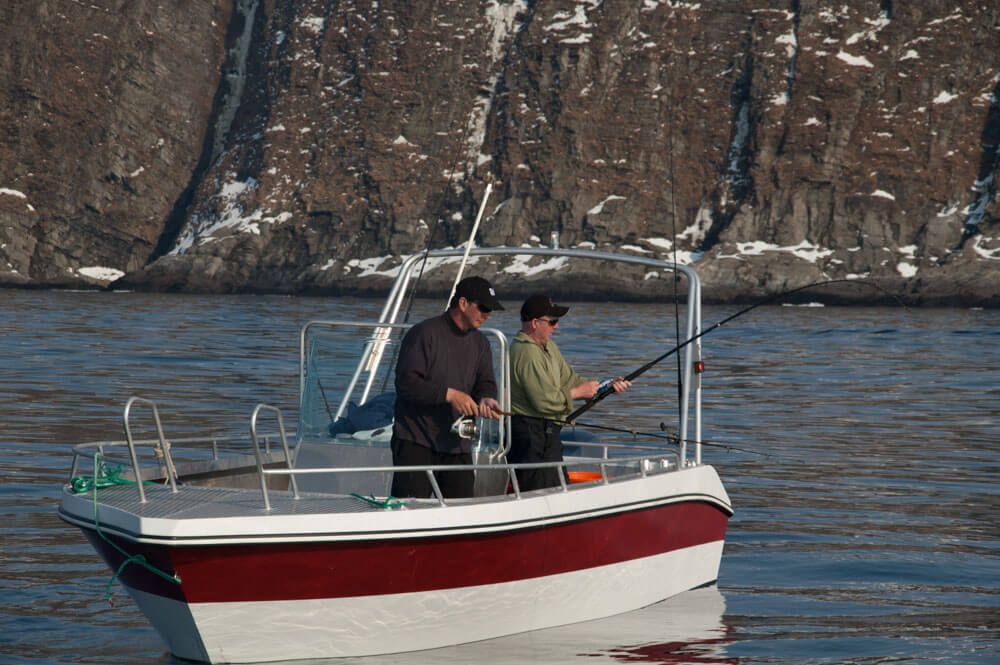
Barney and I tried the eastern side of the two fjords and on the first day chose a drift off Klubbhl Island taking cod to 17lbs in good numbers, the odd wolf fish and torsk, but also small haddock. We then worked much further inside the smaller Langfjord over rising plateau ground called Sloppegr to the east side.
This ground comes up to just 21-metres in places and we chose to fish fly rods for the cod, Barney accounting for a cracking 5lber on the fly, plus we caught large numbers of coalfish to 3lbs and even redfish on the fly. The gradients away from the top of the plateau were paved with fish and at 60-metres the cod and coalfish were shoaled up together. The cod were averaging 4 to 8lbs here, but again Barney bagged a bigger fish around the 13lb mark.
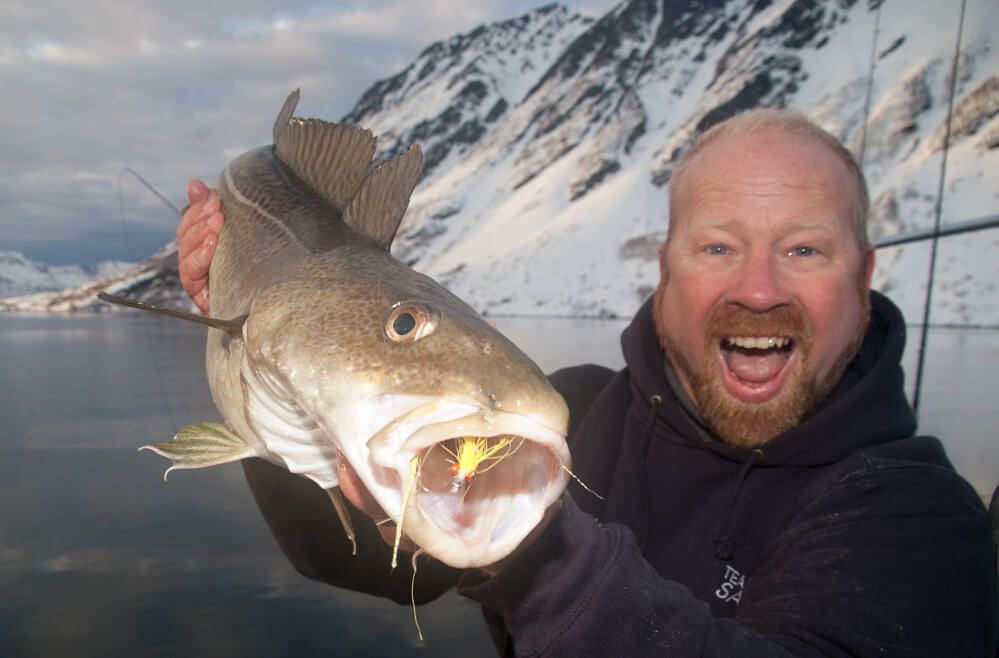
Both boats found the same thing, that the bulk of the fish were sitting on top of the plateau’s, with water in excess of 70-metres being far less productive. Undoubtedly the summer months between July and September will see massive cod inside the inner fjords. The big shoals of coalies with individual fish to potentially 40lbs are typically found in the deeper water in the centre of the fjords, which can reach depths as great as 183-metres, but they swim in the upper surface columns only down to 80-metres depth or so. These inner marks can also give good halibut which seem to favour the ends of rocky headlands where this is some tidal current and steep gradients falling in to deeper water.
Studying the local charts in the evenings the ground that stands out the most lays west of Loppa Island. Access is up through Southbergsfjord, through the shallow sound at Skatnaset between Marehl Island, and west through Kalvsundet Sound to the open sea beyond Loppa Island. It’s a run of around 30 to 35 minutes from base camp. Here the ground comprises peak plateau’s in depths ranging from 24-metres to 100-metres plus.
The knack here is to use the GPS/Fishfinder chart picking out the higher rising peaks and work around these. The fish were mostly on top of the plateaus, but the bigger fish tend to be slightly deeper on the edge of the gradients as they drop away in to deeper water.
Ian and Rodger surveyed this ground first and found incredible numbers of cod on three consecutive days. Ian has fished in the Norwegian waters for over a decade now, and his comment was that he’s never seen so many cod shoaled up so thickly. As the lads let their pirks down to the seabed, they could feel the pirks hitting the backs of the cod, so thickly were they shoaled. It took them just two or three lifts of the pirk and a fish was hooked, often two at a time with triple shots common place.
The other interesting thing was that big cod were mixed in with smaller fish of just 4 and 5lbs, which is unusual…except in Norway!
Barney and I were also working this same ground and took cod to 21lb 12ozs, coalfish to 14lbs, wolffish, torsk, haddock to 5lbs, I also caught my first ever halibut, a fish of 25lbs succumbing to a giant jighead with a shad attached. Ian also found halibut catching two to 10lbs on pirks.
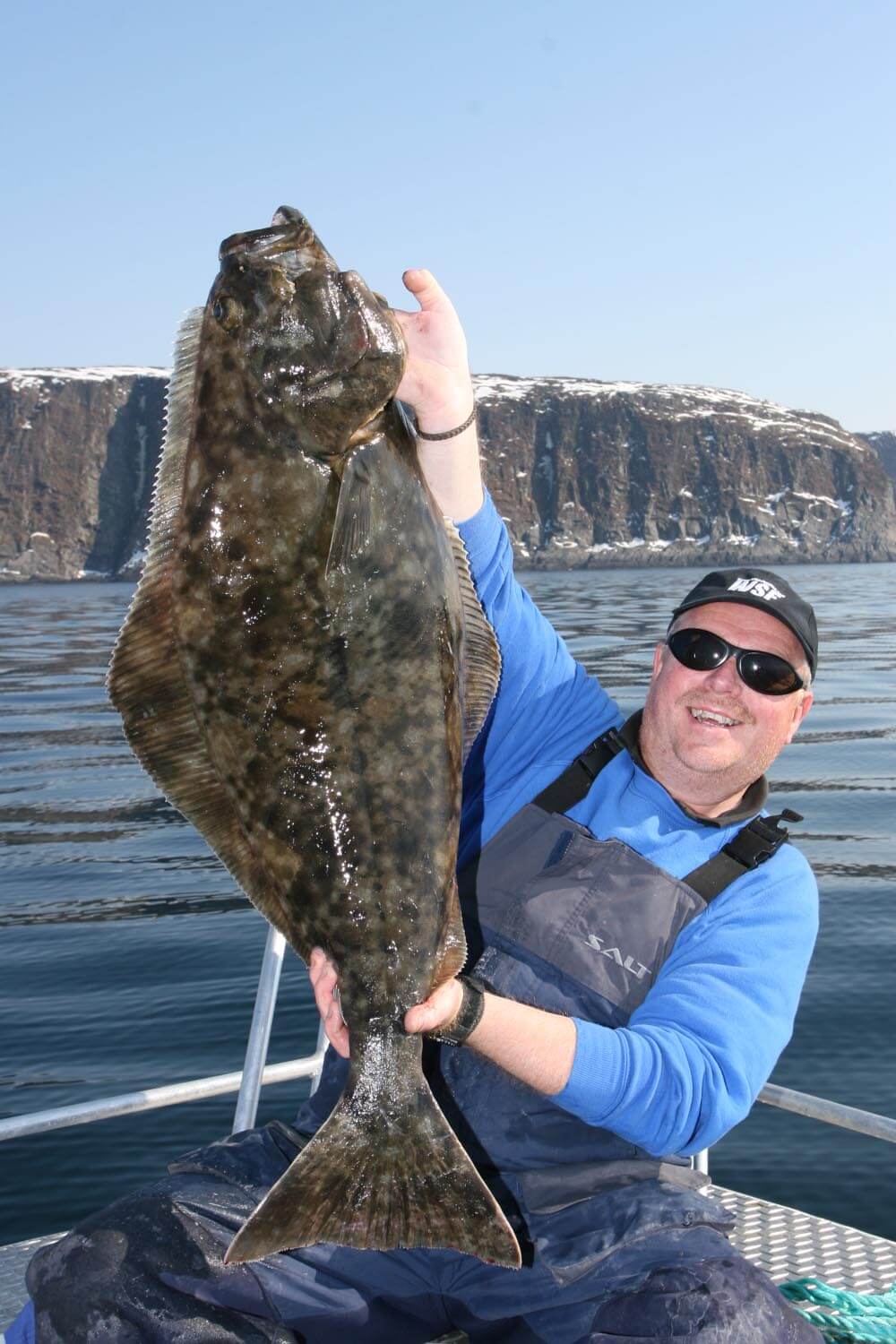
The ground northwest of Loppa Island culminates in a pinnacle called Loeppeboen rising up to 19-metres from 120-metres. I tried to fly fish this, but the drift was just too quick, but in ideal conditions expect big coalies and cod over the top of this to fast sink fly gear. Pirks caught cod here, wolffish and coalfish, but on the day this mark was disappointing.
The ground the lads found most productive lies north of Loppa Island where a huge flat plateau ranges from 35 to 70-metres before dropping away on the west and north side in to 320-metres. This was alive with cod, big haddock, wolffish, torsk and coalies.
In a period of just two hours, on a drift estimated to be over 2-miles in length, Ian and Rodger took cod of 21.08lbs, 24.14lbs, 26.12lbs, 31.3lbs and 35.02lbs, plus a host of cod in the upper teen’s bracket and untold numbers of smaller fish. The 26lber was a personal best for Rodger whose key phrase of the week was “What a lump” due to the peak condition of all the fish! They nicknamed this ground the Loppa Gymnasium as they had such a good work out landing fish non stop all day.
Barney and I fished the same area but different peaks of the plateau with Barney getting a personal best cod of 31lbs, plus a 23lber, I managed to boat a 38lber, plus another to 26lbs, plus we had two small halibut to 7lbs and haddock to 5lbs. We too lost count of the smaller cod in to high double figures with most fish from both boats going back in to the water alive, with just a few fish kept for the table and for the owner of the house we were staying in. In these colder northern waters, where sea temps rarely exceed 6 degrees, the cod are far less prone to suffering the bends and most head straight back for the seabed on release.
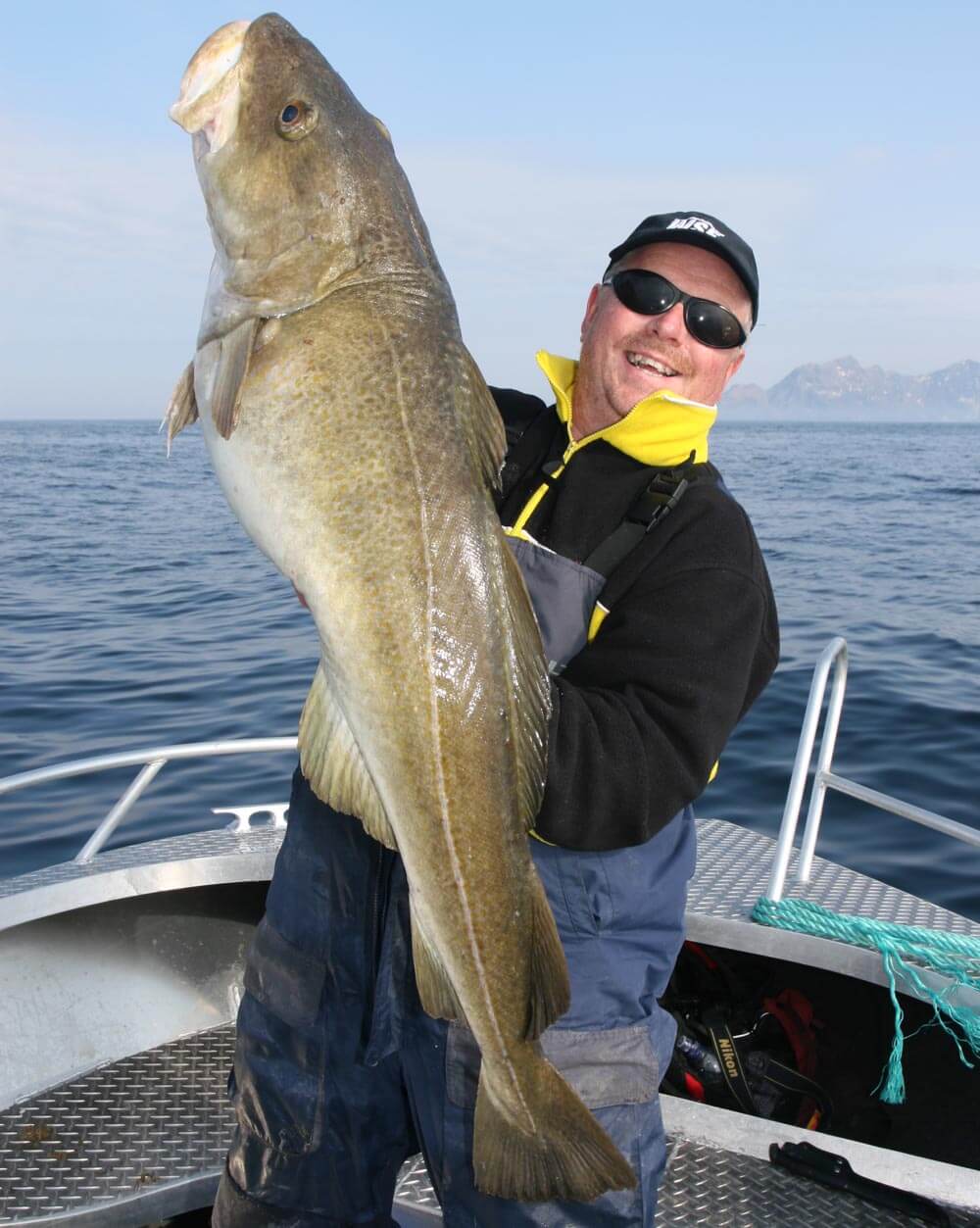
You can see from the photos in the feature Loppa was a blinding success for all four of us and we’re all keen to try and get back there. As a collective, after all we achieved there, we all still feel we’ve only scratched the surface of Loppa’s awesome potential.
One of the locals who has knowledge of the commercial fishing told us that there have been cod to 60kgs caught on the long-lines, plus halibut to 200kgs, coalfish to nearly 30kgs and ling to 45kgs. It’s enough to give you heart palpitations just thinking about it!
SEASONS
We fished Loppa in late April/Early May, but the best of the fishing for the cod and coalies is between July and September. Halibut can show up anytime, but generally the earlier April/May period is deemed to be more consistent, and September can be good too for the smaller fish inside the inner fjords.
Big ling should also be taken from the deeper areas of the inner fjords in high summer, but you’ll need to bait your pirks and jigheads for these. Half fillets of cod or coalie are good.
General ground fish such as haddock, wolffish, torsk and blue whiting are virtually all summer through fish. Small strips of coalies catch these.
TACKLE
A 30lb rod is the best choice for most of the fishing, but choose one with a supple tip designed for braided line, but with power in the lower mid section and butt to master the very big fish. Longer rods over 8ft give the lure more action and will improve the catch ratio. Good reels are the Penn Torque 100 or the Shimano Takota for comparison.
Some anglers may prefer a heavier 30/50 outfit matched to a bigger reel such as a Penn Torque 200 loaded with 50lb braid. If you’re after a halibut in excess of 80lbs, then this might be the best choice.
Most pirks will catch fish, such as the Solvkroken type, also the normal chrome bar pirks, but a good tip is to add either flash foil to the shank of the treble hook, or add a small pink or black muppet on the hook shank to give the pirk more attraction. It’s also worth noting that Ian rates black pirks which is a colour that hammers predatory fish all round the world.
When the fish are up in the water, the new type Butterfly jigs will also do well as their action is to lift then dart off at an angle on the descent which is a motion particularly attractive to feeding cod.
If you want to specifically target the bigger fish, then the proven Sea Waver lures invented by German Angling Journalist Volker Dapoz are unbeatable. I hardly used a pirk all week and stuck just with the giant jigheads which caught the halibut and all my bigger cod including the 38lber with a black shad attached.
Also take a spinning rod, say 1 to 3ozs, which can be used in shallow water with smaller spinners and weighted shads. Load this with 20lb braid. This type of outfit caught cod over 20lbs for Rodger.
Fly rods need to be a minimum of a 10-weight, maybe 12-weight if you’ve the really big coalies in mind. Lines need to be ultra fast sink types, or a fast sink shooting head. Use Fluoro carbon tippets between 15lbs and 30lbs as the water is gin clear way down. Flies need to be heavy headed to get down deep and tied on hook sizes 2/0 to 4/0.
Take spare braided line and mono leader with you, plenty of heavy duty snap links, though quality size 4/0 rolling swivels and Mustad 3/0 oval split-rings are a good alternative, some big hooks if you want to use baits such as half a fillet of coalie, plus some heavier 80lb and 200lb mono, and that’s about all you’ll need.
Take warm clothing as a north wind can still cut to the bone even in summer, and remember you have pretty much 24 hrs of daylight from late April through to late August, so you can fish through the night if need be.
BOATS
We were fishing from Norwegian built 22ft and 19ft Kvaerno alloy boats fitted with Yamaha 115hp and 60hp 4-stroke outboards respectively. The 22fter will do around 24-knots easy cruising, and the 19fter 17-knots at around 4200 RPM. The 22 would fish three very comfortably and the 19 would be fine for three if you keep all your gear stowed.
The boats are superb sea boats and we felt totally safe in all sea conditions at all times.
HOW TO GET THERE
We took a single flight from Stanstead direct to Tromso, then hire car to the ferry at Oksfjord, which takes you direct to Tervfjord which is roughly 2.5 hours sailing time.
ACCOMMODATION
We stayed in a 4 bedroom house, beautifully furnished with a fully equipped kitchen, bathroom and drying facilities, just 100-yds from the moored boats which you can see from the lounge room of the house.
There’s a shop dead opposite the house which carries all basic supplies, but make sure you keep stocked up as they only have two deliveries a week. Take any alcohol with you as the shop does not stock any.
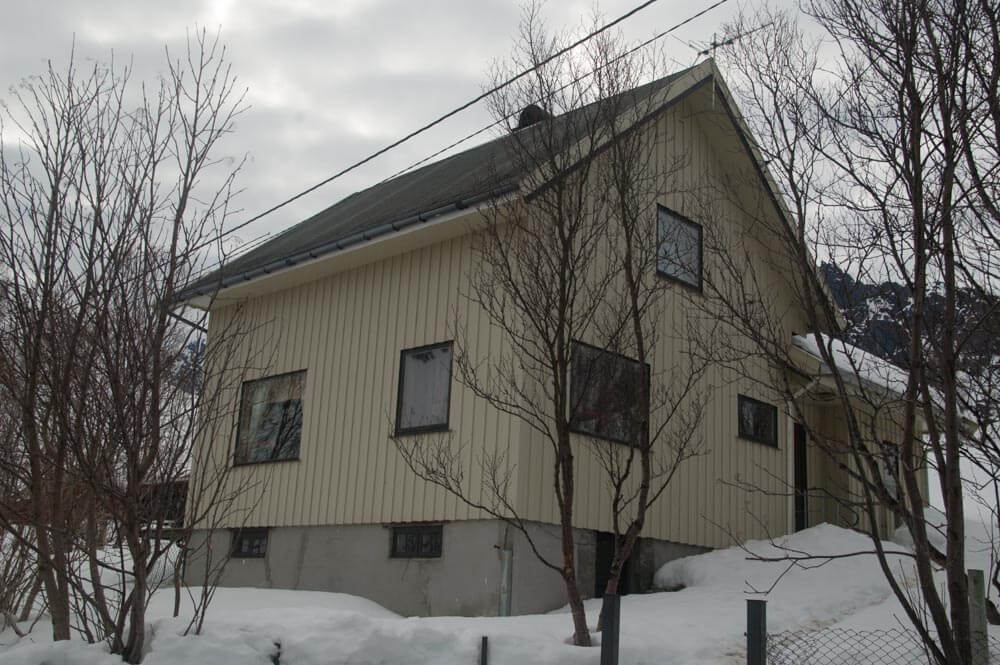
CONTACT
For further information and package prices for Loppa contact Ian Peacock, Din Tur Booking Office, Northeast Tackle Supplies Ltd, 309 Ryehope Road, Sunderland, SR2 9SS. Tel: 0191 5654970. E-mail: peacock@dintur.co.uk . Also access the Din Tur website at www.dintur.co.uk .
Din Tur offer over 200 alternative sea angling destinations and holiday packages, so there is something for everyone whether you just want to catch lots of fish or try for those northern whoppers!
A four man team consisting of Ian Peacock, UK representative for the Norwegian tour company Din Tur, Barney Wright, editor of TSF, Roger Mortimore, sub editor, and myself headed to Loppa in the far north of Norway with two prime targets. One was to catch the holy grail of European sea angling, a halibut, the other to assess the cod fishing and general potential of an area only just being opened up to UK anglers.
Base camp was the village of Tverfjord situated inside Langfjord south of Silda Island. This gave us access to ground inside Langfjord, other known fishing grounds around Maroy Island, both Northbergsfjord and Southbergsfjord, but importantly the ground west, northwest and north of Loppa Island.

With this area being new and unexplored by UK anglers we chose to split in to two man teams and spend the first three days surveying the ground relatively close to base camp. This is ground that could be fished in most weather conditions meaning few if any days would be lost for future visiting anglers.
Ian and Roger fished ground inside Silsporden Sound between Silda and Maroy Island taking cod to double figures, wolffish, torsk and haddock, but also found good cod when drifting down the west side of Maroy, and also off a rocky point where shallow water drops away deep at Panarskj at the entrance to Langfjord less than a mile away from the boat dock.
The two lads then ventured northwards to the top of Northbergsfjord, a run of about 25 minutes, where the chart indicates superb featured ground named Rundskj and Konesgr with depths from 30-metres dropping in to 100-metres plus. The local Norwegian longliners were already working this ground, but the guys made drifts between and outside the lines and enjoyed incredible fishing with huge numbers of cod in to the high teens in weight. Their tackle was typically a pirk at the bottom with a single, or two flyer lures above.

Barney and I tried the eastern side of the two fjords and on the first day chose a drift off Klubbhl Island taking cod to 17lbs in good numbers, the odd wolf fish and torsk, but also small haddock. We then worked much further inside the smaller Langfjord over rising plateau ground called Sloppegr to the east side.
This ground comes up to just 21-metres in places and we chose to fish fly rods for the cod, Barney accounting for a cracking 5lber on the fly, plus we caught large numbers of coalfish to 3lbs and even redfish on the fly. The gradients away from the top of the plateau were paved with fish and at 60-metres the cod and coalfish were shoaled up together. The cod were averaging 4 to 8lbs here, but again Barney bagged a bigger fish around the 13lb mark.

Both boats found the same thing, that the bulk of the fish were sitting on top of the plateau’s, with water in excess of 70-metres being far less productive. Undoubtedly the summer months between July and September will see massive cod inside the inner fjords. The big shoals of coalies with individual fish to potentially 40lbs are typically found in the deeper water in the centre of the fjords, which can reach depths as great as 183-metres, but they swim in the upper surface columns only down to 80-metres depth or so. These inner marks can also give good halibut which seem to favour the ends of rocky headlands where this is some tidal current and steep gradients falling in to deeper water.
Studying the local charts in the evenings the ground that stands out the most lays west of Loppa Island. Access is up through Southbergsfjord, through the shallow sound at Skatnaset between Marehl Island, and west through Kalvsundet Sound to the open sea beyond Loppa Island. It’s a run of around 30 to 35 minutes from base camp. Here the ground comprises peak plateau’s in depths ranging from 24-metres to 100-metres plus.
The knack here is to use the GPS/Fishfinder chart picking out the higher rising peaks and work around these. The fish were mostly on top of the plateaus, but the bigger fish tend to be slightly deeper on the edge of the gradients as they drop away in to deeper water.
Ian and Rodger surveyed this ground first and found incredible numbers of cod on three consecutive days. Ian has fished in the Norwegian waters for over a decade now, and his comment was that he’s never seen so many cod shoaled up so thickly. As the lads let their pirks down to the seabed, they could feel the pirks hitting the backs of the cod, so thickly were they shoaled. It took them just two or three lifts of the pirk and a fish was hooked, often two at a time with triple shots common place.
The other interesting thing was that big cod were mixed in with smaller fish of just 4 and 5lbs, which is unusual…except in Norway!
Barney and I were also working this same ground and took cod to 21lb 12ozs, coalfish to 14lbs, wolffish, torsk, haddock to 5lbs, I also caught my first ever halibut, a fish of 25lbs succumbing to a giant jighead with a shad attached. Ian also found halibut catching two to 10lbs on pirks.

The ground northwest of Loppa Island culminates in a pinnacle called Loeppeboen rising up to 19-metres from 120-metres. I tried to fly fish this, but the drift was just too quick, but in ideal conditions expect big coalies and cod over the top of this to fast sink fly gear. Pirks caught cod here, wolffish and coalfish, but on the day this mark was disappointing.
The ground the lads found most productive lies north of Loppa Island where a huge flat plateau ranges from 35 to 70-metres before dropping away on the west and north side in to 320-metres. This was alive with cod, big haddock, wolffish, torsk and coalies.
In a period of just two hours, on a drift estimated to be over 2-miles in length, Ian and Rodger took cod of 21.08lbs, 24.14lbs, 26.12lbs, 31.3lbs and 35.02lbs, plus a host of cod in the upper teen’s bracket and untold numbers of smaller fish. The 26lber was a personal best for Rodger whose key phrase of the week was “What a lump” due to the peak condition of all the fish! They nicknamed this ground the Loppa Gymnasium as they had such a good work out landing fish non stop all day.
Barney and I fished the same area but different peaks of the plateau with Barney getting a personal best cod of 31lbs, plus a 23lber, I managed to boat a 38lber, plus another to 26lbs, plus we had two small halibut to 7lbs and haddock to 5lbs. We too lost count of the smaller cod in to high double figures with most fish from both boats going back in to the water alive, with just a few fish kept for the table and for the owner of the house we were staying in. In these colder northern waters, where sea temps rarely exceed 6 degrees, the cod are far less prone to suffering the bends and most head straight back for the seabed on release.

You can see from the photos in the feature Loppa was a blinding success for all four of us and we’re all keen to try and get back there. As a collective, after all we achieved there, we all still feel we’ve only scratched the surface of Loppa’s awesome potential.
One of the locals who has knowledge of the commercial fishing told us that there have been cod to 60kgs caught on the long-lines, plus halibut to 200kgs, coalfish to nearly 30kgs and ling to 45kgs. It’s enough to give you heart palpitations just thinking about it!
SEASONS
We fished Loppa in late April/Early May, but the best of the fishing for the cod and coalies is between July and September. Halibut can show up anytime, but generally the earlier April/May period is deemed to be more consistent, and September can be good too for the smaller fish inside the inner fjords.
Big ling should also be taken from the deeper areas of the inner fjords in high summer, but you’ll need to bait your pirks and jigheads for these. Half fillets of cod or coalie are good.
General ground fish such as haddock, wolffish, torsk and blue whiting are virtually all summer through fish. Small strips of coalies catch these.
TACKLE
A 30lb rod is the best choice for most of the fishing, but choose one with a supple tip designed for braided line, but with power in the lower mid section and butt to master the very big fish. Longer rods over 8ft give the lure more action and will improve the catch ratio. Good reels are the Penn Torque 100 or the Shimano Takota for comparison.
Some anglers may prefer a heavier 30/50 outfit matched to a bigger reel such as a Penn Torque 200 loaded with 50lb braid. If you’re after a halibut in excess of 80lbs, then this might be the best choice.
Most pirks will catch fish, such as the Solvkroken type, also the normal chrome bar pirks, but a good tip is to add either flash foil to the shank of the treble hook, or add a small pink or black muppet on the hook shank to give the pirk more attraction. It’s also worth noting that Ian rates black pirks which is a colour that hammers predatory fish all round the world.
When the fish are up in the water, the new type Butterfly jigs will also do well as their action is to lift then dart off at an angle on the descent which is a motion particularly attractive to feeding cod.
If you want to specifically target the bigger fish, then the proven Sea Waver lures invented by German Angling Journalist Volker Dapoz are unbeatable. I hardly used a pirk all week and stuck just with the giant jigheads which caught the halibut and all my bigger cod including the 38lber with a black shad attached.
Also take a spinning rod, say 1 to 3ozs, which can be used in shallow water with smaller spinners and weighted shads. Load this with 20lb braid. This type of outfit caught cod over 20lbs for Rodger.
Fly rods need to be a minimum of a 10-weight, maybe 12-weight if you’ve the really big coalies in mind. Lines need to be ultra fast sink types, or a fast sink shooting head. Use Fluoro carbon tippets between 15lbs and 30lbs as the water is gin clear way down. Flies need to be heavy headed to get down deep and tied on hook sizes 2/0 to 4/0.
Take spare braided line and mono leader with you, plenty of heavy duty snap links, though quality size 4/0 rolling swivels and Mustad 3/0 oval split-rings are a good alternative, some big hooks if you want to use baits such as half a fillet of coalie, plus some heavier 80lb and 200lb mono, and that’s about all you’ll need.
Take warm clothing as a north wind can still cut to the bone even in summer, and remember you have pretty much 24 hrs of daylight from late April through to late August, so you can fish through the night if need be.
BOATS
We were fishing from Norwegian built 22ft and 19ft Kvaerno alloy boats fitted with Yamaha 115hp and 60hp 4-stroke outboards respectively. The 22fter will do around 24-knots easy cruising, and the 19fter 17-knots at around 4200 RPM. The 22 would fish three very comfortably and the 19 would be fine for three if you keep all your gear stowed.
The boats are superb sea boats and we felt totally safe in all sea conditions at all times.
HOW TO GET THERE
We took a single flight from Stanstead direct to Tromso, then hire car to the ferry at Oksfjord, which takes you direct to Tervfjord which is roughly 2.5 hours sailing time.
ACCOMMODATION
We stayed in a 4 bedroom house, beautifully furnished with a fully equipped kitchen, bathroom and drying facilities, just 100-yds from the moored boats which you can see from the lounge room of the house.
There’s a shop dead opposite the house which carries all basic supplies, but make sure you keep stocked up as they only have two deliveries a week. Take any alcohol with you as the shop does not stock any.

CONTACT
For further information and package prices for Loppa contact Ian Peacock, Din Tur Booking Office, Northeast Tackle Supplies Ltd, 309 Ryehope Road, Sunderland, SR2 9SS. Tel: 0191 5654970. E-mail: peacock@dintur.co.uk . Also access the Din Tur website at www.dintur.co.uk .
Din Tur offer over 200 alternative sea angling destinations and holiday packages, so there is something for everyone whether you just want to catch lots of fish or try for those northern whoppers!

